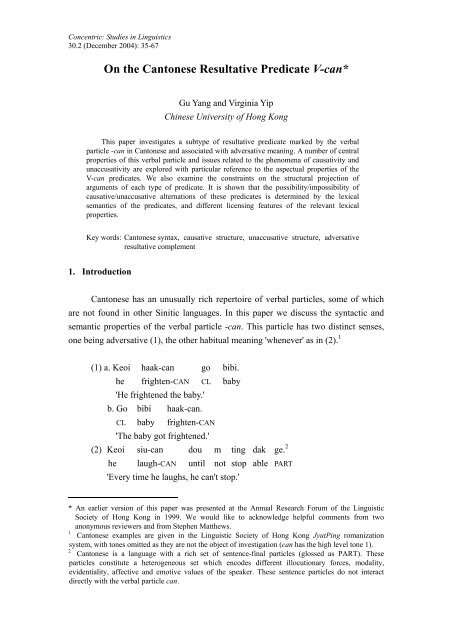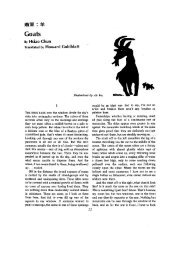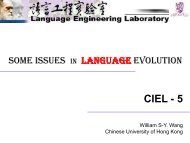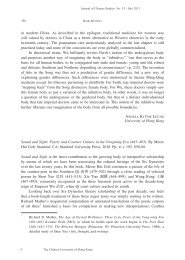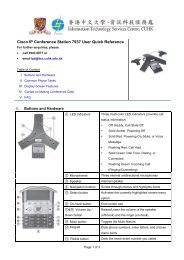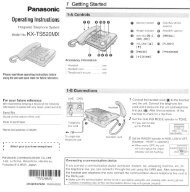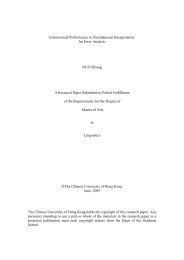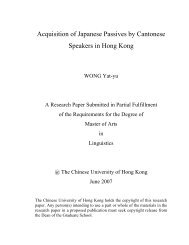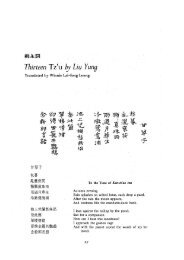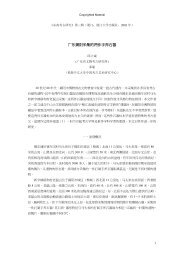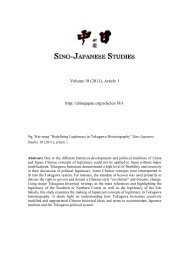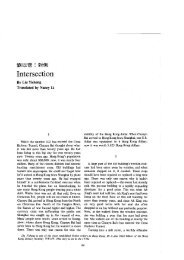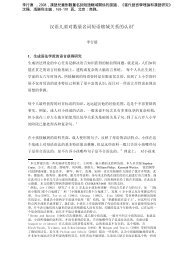On the Cantonese Resultative Predicate V-can
On the Cantonese Resultative Predicate V-can
On the Cantonese Resultative Predicate V-can
Create successful ePaper yourself
Turn your PDF publications into a flip-book with our unique Google optimized e-Paper software.
Concentric: Studies in Linguistics<br />
30.2 (December 2004): 35-67<br />
<strong>On</strong> <strong>the</strong> <strong>Cantonese</strong> <strong>Resultative</strong> <strong>Predicate</strong> V-<strong>can</strong>*<br />
Gu Yang and Virginia Yip<br />
Chinese University of Hong Kong<br />
This paper investigates a subtype of resultative predicate marked by <strong>the</strong> verbal<br />
particle -<strong>can</strong> in <strong>Cantonese</strong> and associated with adversative meaning. A number of central<br />
properties of this verbal particle and issues related to <strong>the</strong> phenomena of causativity and<br />
unaccusativity are explored with particular reference to <strong>the</strong> aspectual properties of <strong>the</strong><br />
V-<strong>can</strong> predicates. We also examine <strong>the</strong> constraints on <strong>the</strong> structural projection of<br />
arguments of each type of predicate. It is shown that <strong>the</strong> possibility/impossibility of<br />
causative/unaccusative alternations of <strong>the</strong>se predicates is determined by <strong>the</strong> lexical<br />
semantics of <strong>the</strong> predicates, and different licensing features of <strong>the</strong> relevant lexical<br />
properties.<br />
Key words: <strong>Cantonese</strong> syntax, causative structure, unaccusative structure, adversative<br />
resultative complement<br />
1. Introduction<br />
<strong>Cantonese</strong> has an unusually rich repertoire of verbal particles, some of which<br />
are not found in o<strong>the</strong>r Sinitic languages. In this paper we discuss <strong>the</strong> syntactic and<br />
semantic properties of <strong>the</strong> verbal particle -<strong>can</strong>. This particle has two distinct senses,<br />
one being adversative (1), <strong>the</strong> o<strong>the</strong>r habitual meaning 'whenever' as in (2). 1<br />
(1) a. Keoi haak-<strong>can</strong> go bibi.<br />
he frighten-CAN CL baby<br />
'He frightened <strong>the</strong> baby.'<br />
b. Go bibi haak-<strong>can</strong>.<br />
CL baby frighten-CAN<br />
'The baby got frightened.'<br />
(2) Keoi siu-<strong>can</strong> dou m ting dak ge. 2<br />
he laugh-CAN until not stop able PART<br />
'Every time he laughs, he <strong>can</strong>'t stop.'<br />
* An earlier version of this paper was presented at <strong>the</strong> Annual Research Forum of <strong>the</strong> Linguistic<br />
Society of Hong Kong in 1999. We would like to acknowledge helpful comments from two<br />
anonymous reviewers and from Stephen Mat<strong>the</strong>ws.<br />
1 <strong>Cantonese</strong> examples are given in <strong>the</strong> Linguistic Society of Hong Kong JyutPing romanization<br />
system, with tones omitted as <strong>the</strong>y are not <strong>the</strong> object of investigation (<strong>can</strong> has <strong>the</strong> high level tone 1).<br />
2 <strong>Cantonese</strong> is a language with a rich set of sentence-final particles (glossed as PART). These<br />
particles constitute a heterogeneous set which encodes different illocutionary forces, modality,<br />
evidentiality, affective and emotive values of <strong>the</strong> speaker. These sentence particles do not interact<br />
directly with <strong>the</strong> verbal particle <strong>can</strong>.
30.2 (December 2004)<br />
Our discussion focuses on -<strong>can</strong> with adversative meaning as in (1a) and (1b), which<br />
occurs with a restricted class of verbs to form a complex verbal predicate. We shall<br />
examine <strong>the</strong> argument structure of <strong>the</strong> [V-<strong>can</strong>] predicate in relation to ergativity as<br />
defined in Keyser and Roeper (1984) and Hale and Keyser (1993), i.e. <strong>the</strong> alternation<br />
between transitive and unaccusative argument structures. The findings presented here<br />
represent a small but signifi<strong>can</strong>t piece of <strong>the</strong> overall puzzle of <strong>Cantonese</strong> argument<br />
structure.<br />
As discussed in Mat<strong>the</strong>ws and Yip (1994), -<strong>can</strong> is a verbal particle which has an<br />
adversative meaning in that <strong>the</strong> effect is "to one's disadvantage/misfortune" (1994:<br />
227). 3 Building on previous analyses, we fine-tune <strong>the</strong> syntax and semantics of -<strong>can</strong><br />
in light of current linguistic <strong>the</strong>ory. We <strong>the</strong>n situate <strong>the</strong> analysis within a broader<br />
picture of causativity and ergativity, analyzing -<strong>can</strong> as a morpheme associated with a<br />
subset of transitive/causative and unaccusative predicates. Comparisons with English<br />
are also adduced to support our analysis.<br />
2. Classification of verbs<br />
2.1 Intransitive verbs: Unergatives and unaccusatives<br />
In order to distinguish different verb classes in <strong>Cantonese</strong>, we need to appeal to<br />
<strong>the</strong> typology of verbs (Pinker 1989; Levin & Rappaport Hovav 1995) by dividing<br />
verbs into transitive/causative and intransitive, which sub-divides into unergative and<br />
unaccusative. Languages differ in <strong>the</strong> sets of verbs that fall into <strong>the</strong>se categories. The<br />
intransitives have at least two distinct <strong>the</strong>matic cores associated with <strong>the</strong>m (cf. Pinker<br />
1989:87):<br />
(3) Intransitive verbs<br />
a. Unergative verbs<br />
whose argument structure contains one member bearing a <strong>the</strong>ta-role<br />
which denotes prototypically an entity (Agent) who performs some<br />
action or activity (e.g. run, walk, sleep, eat, brea<strong>the</strong>, cry and dance, etc.<br />
in English) Unergative V: <br />
b. Unaccusative verbs<br />
whose argument structure contains one member bearing a <strong>the</strong>ta-role<br />
which denotes an entity (Theme) that exists in or undergoes some<br />
change of location or state (e.g. bounce, open, fall and arrive etc. in<br />
English) Unaccusative V: <br />
3 Unlike its Mandarin cognate qing, <strong>Cantonese</strong> <strong>can</strong> <strong>can</strong>not be used as a verb in its own right, hence <strong>the</strong><br />
term 'particle': –<strong>can</strong> is highly grammaticalised, without retaining any lexical meaning.<br />
36
Gu and Yip: <strong>Cantonese</strong> resultative V-CAN<br />
Under standard assumptions (see for example Levin & Rappaport Hovav 1995), <strong>the</strong><br />
change of location or state of <strong>the</strong> <strong>the</strong>me of an unaccusative verb is due to some<br />
internal ra<strong>the</strong>r than external force. Hence <strong>the</strong> <strong>the</strong>me is also conceived as an internal<br />
argument whereas <strong>the</strong> agent argument is referred to as an external argument. The<br />
external and internal arguments have distinct syntactic properties (Williams 1994) and<br />
our discussion on <strong>the</strong> <strong>Cantonese</strong> V-<strong>can</strong> predicates fur<strong>the</strong>r illustrates <strong>the</strong> distinction.<br />
The fact that unaccusativity has drawn so much attention in current studies of<br />
syntax, regardless of <strong>the</strong>oretical framework, testifies to <strong>the</strong> signifi<strong>can</strong>ce of <strong>the</strong><br />
widespread grammatical consequences of <strong>the</strong> unaccusative/unergative distinction. Our<br />
investigation shows that this distinction <strong>can</strong> be captured in a principled manner in<br />
<strong>Cantonese</strong>.<br />
2.2 Ergativity<br />
It is well documented in <strong>the</strong> literature that causative verbs often have<br />
unaccusative correlates depending on <strong>the</strong> lexical semantic meaning of <strong>the</strong> source<br />
verbs. In o<strong>the</strong>r words, <strong>the</strong>y exhibit ergativity in <strong>the</strong> sense of Keyser and Roeper<br />
(1984). Gu (1996) discusses <strong>the</strong> transitive/unaccusative alternations of monosyllabic<br />
verbs in Mandarin, a language closely related to <strong>Cantonese</strong>, as illustrated in (4) and (5)<br />
where <strong>the</strong> (a) examples illustrate <strong>the</strong> transitive/causative use of <strong>the</strong> verb and <strong>the</strong> (b)<br />
examples <strong>the</strong> corresponding unaccusative use:<br />
(4) a. Ta mie-le huo.<br />
she extinguish -ASP fire<br />
'She put out <strong>the</strong> fire.'<br />
b. Huo mie- le.<br />
fire extinguish-ASP<br />
'The fire went out.'<br />
(5) a. Shuishou men chen-le chuan.<br />
sailors sink-ASP boat<br />
'The sailors sank <strong>the</strong> boat.'<br />
b. Chuan chen-le.<br />
boat sink-ASP<br />
'The boat sank.'<br />
Examples of monosyllabic verbs that undergo <strong>the</strong> transitive/unaccusative alternations<br />
in <strong>Cantonese</strong> are given in (6) and (7):<br />
37
30.2 (December 2004)<br />
(6) a. Keoi sik-zo zaan dang.<br />
she turn off - ASP CL light<br />
'She turned off <strong>the</strong> light.'<br />
b. Zaan dang sik-zo.<br />
CL light turn off-ASP<br />
'The light turned off (by itself).'<br />
(7) a. Zek maau haak-zo ngo jat tiu.<br />
CL cat frighten-ASP I one jerk<br />
'The cat startled me.'<br />
b. Ngo haak-zo jat tiu.<br />
I frighten-ASP one jerk<br />
'I got startled.'<br />
The examples in (4-7) illustrate that <strong>the</strong> transitive/unaccusative alternation is<br />
instantiated in both Mandarin and <strong>Cantonese</strong>. In accordance with <strong>the</strong> Unaccusative<br />
Hypo<strong>the</strong>sis (Perlmutter 1978), which distinguishes unergative verbs that have a single<br />
external argument and no direct internal argument from unaccusative verbs that have<br />
a single internal argument and no external argument, we divide intransitive verbs in<br />
<strong>Cantonese</strong> into unergative verbs on <strong>the</strong> one hand (8a), and ergative (8bi) and<br />
unaccusative (8bii) verbs on <strong>the</strong> o<strong>the</strong>r:<br />
(8) a. Unergative verbs: haam 'cry', siu 'laugh', tiu 'jump', fan-gaau 'sleep', etc.<br />
b. i. Ergative verbs (those showing transitive/unaccusative alternations):<br />
hoi 'open', saan 'close', haak 'frighten', ngo 'starve', etc.<br />
ii.Unaccusative verbs (non-alternating verbs with no<br />
transitive/causative counterpart): dit 'fall', puk 'trip', faatsang 'happen',<br />
etc.<br />
Like o<strong>the</strong>r languages, <strong>Cantonese</strong> distinguishes unaccusatives from passives. As<br />
exemplified in (9), passive verbs like those in (9b) are correlated with transitive verbs<br />
as in (9a), but <strong>the</strong>y are not correlated with unaccusative verbs as in (9c). This is in line<br />
with <strong>the</strong> analysis of Levin and Rappaport Hovav (1995) that unaccusative verbs have<br />
no external argument, whereas passive verbs are derived from <strong>the</strong>ir transitive<br />
counterparts in a process whereby <strong>the</strong> agent <strong>the</strong>ta role is demoted to an adjunct<br />
position. This explains <strong>the</strong> presence of keoi 'she/her' as an agent in (9a) and (9b), and<br />
its absence in (9c).<br />
38
(9) a. Keoi saan-zo dou mun.<br />
she close-ASP CL door<br />
'She closed <strong>the</strong> door.'<br />
b. Dou mun bei keoi saan-zo.<br />
CL door by her close-ASP<br />
'The door was closed by her.'<br />
c. Dou mun saan-zo.<br />
CL door close-ASP<br />
'The door closed.'<br />
Gu and Yip: <strong>Cantonese</strong> resultative V-CAN<br />
The presence of an external argument who intentionally brings about a change of state<br />
<strong>can</strong> be diagnosed by adverbs such as dakdang 'deliberately' which needs an agent to<br />
licence it. The contrast between <strong>the</strong> compatibility of dakdang 'deliberately' with <strong>the</strong><br />
passive and its incompatability with unaccusative saan 'close' is shown in (10):<br />
(10) a. Dou mun bei keoi dakdang saan-zo.<br />
CL door by her deliberately close-ASP<br />
'The door was closed by her deliberately.'<br />
b.*Dou mun dakdang saan-zo.<br />
CL door deliberately close-ASP<br />
'The door closed deliberately.'<br />
The agent-oriented adverb dakdang 'intentionally' is licensed by <strong>the</strong> agent keoi in (10a)<br />
whereas it is not licensed in (10b) since <strong>the</strong> adverb <strong>can</strong>not modify a predicate which<br />
does not encode agentivity.<br />
(9a) and (9c) illustrate that unaccusative verbs may have transitive counterparts.<br />
When this happens, <strong>the</strong> two of <strong>the</strong>m form an ergative pair, and <strong>the</strong> transitive member<br />
of <strong>the</strong> pair <strong>can</strong> undergo passivization. But not all unaccusative verbs have transitive<br />
counterparts. This is illustrated in (11), where <strong>the</strong> verb dit 'fall' <strong>can</strong>not be used<br />
transitively nor passively:<br />
(11) a. Go bibi dit-zo lok dei.<br />
CL baby fall-ASP down floor<br />
'The baby fell on <strong>the</strong> floor.'<br />
39
30.2 (December 2004)<br />
b. *Siu Ming dit-zo go bibi lok dei. 4<br />
Siu Ming fall- ASP CL baby down floor<br />
'Siu Ming caused <strong>the</strong> baby to fall on <strong>the</strong> floor.'<br />
c. * Go bibi bei Siu Ming dit-zo lok dei.<br />
CL baby by Siu Ming fall-ASP down floor<br />
'The baby was fallen on <strong>the</strong> floor by Siu Ming.'<br />
In <strong>the</strong> following, we will examine properties of <strong>the</strong> V-<strong>can</strong> predicates in relation to<br />
<strong>the</strong>ir compatibility with transitive, passive, ergative and unaccusative constructions.<br />
3. The semantics of -<strong>can</strong><br />
There are a number of semantic properties associated with -<strong>can</strong>, including<br />
adversity, experientiality and resultativity. Our discussion will begin with <strong>the</strong> most<br />
salient semantic feature of adversity.<br />
3.1 Adversity<br />
The morpheme -<strong>can</strong> occurs with a restricted set of monosyllabic verbs which<br />
denote activities. The combination V-<strong>can</strong> is a predicate depicting some adverse<br />
resultant state: in (12a) and (12b), for instance, <strong>the</strong> adverse effect is on <strong>the</strong> object<br />
sailouzai 'child' and hoksaang 'students' while in (12c) <strong>the</strong> disadvantage is to <strong>the</strong><br />
subject wandungjyun 'athlete'.<br />
(12) a. Zek gau aau-<strong>can</strong> go sailouzai.<br />
CL dog bite-CAN CL child<br />
'The dog bit <strong>the</strong> child.'<br />
b. Tou hei mun-<strong>can</strong> di hoksaang.<br />
CL movie bore-CAN CL students<br />
'The movie bored <strong>the</strong> students.'<br />
4 Example (11b) also has a grammatical reading: 'Siu Ming inadvertently let <strong>the</strong> baby fall onto <strong>the</strong><br />
floor'. When <strong>the</strong> noun phrase following <strong>the</strong> unaccusative verb dit 'fall' forms a possessor/possessee<br />
relation with <strong>the</strong> surface subject, for instance, doi 'bag' or nganbaau 'wallet' in (i), <strong>the</strong> sentence is<br />
grammatical:<br />
(i) Siu Ming dit-zo go doi/nganbaau lok dei.<br />
Siu Ming fall-ASP CL bag/wallet down floor<br />
(Lit.) 'Siu Ming’s bag fell on <strong>the</strong> floor.'<br />
This shows that (i) does not have an au<strong>the</strong>ntic transitive structure, but results from possessor raising<br />
(see <strong>the</strong> discussion in Section 4 for more details).<br />
40
c. Go wandungjyun zam-<strong>can</strong>.<br />
CL sportsman drown-CAN<br />
'The athlete drowned.'<br />
Gu and Yip: <strong>Cantonese</strong> resultative V-CAN<br />
As we proceed, it <strong>can</strong> be noted that -<strong>can</strong> is ra<strong>the</strong>r selective in terms of <strong>the</strong> adversative<br />
verbs that it occurs with. Some are ergatives, exhibiting <strong>the</strong> transitive/unaccusative<br />
alternation, while some are unaccusative verbs without a transitive counterpart.<br />
However, -<strong>can</strong> <strong>can</strong>not occur with unergatives, as we will see shortly.<br />
3.2 Experientiality<br />
The morpheme -<strong>can</strong> occurs with a number of psychological predicates which denote<br />
activities resulting in some adverse states, e.g.:<br />
(13) a. Go hoksaang gik-<strong>can</strong> keoi.<br />
CL student anger-CAN her<br />
'The students made her angry.'<br />
b. Tou hei mun-<strong>can</strong> ngo.<br />
CL movie bore-CAN me<br />
'The movie bored me.'<br />
(14) a. Zek gau haak-<strong>can</strong> zek maau.<br />
CL dog frighten-CAN CL cat<br />
'The dog scared <strong>the</strong> cat.'<br />
b. Keoi gong ge je faan-<strong>can</strong> ngo. 5<br />
he say REL thing annoy-CAN me<br />
'What he said annoyed me.'<br />
What unifies <strong>the</strong> verbs in (13) and (14) and <strong>the</strong> ones seen earlier is that <strong>the</strong>se<br />
predicates subcategorise for a β Experiencer object (in <strong>the</strong> sense of Brekke 1988) or<br />
alternatively, <strong>the</strong> predicates are Object Experiencer (ObjExp) predicates as discussed<br />
in Pesetsky (1987, 1995); <strong>the</strong> adversative effect is on <strong>the</strong> experiencer. In (14), for<br />
instance, <strong>the</strong> argument that receives <strong>the</strong> adversative interpretation bears a <strong>the</strong>ta-role of<br />
experiencer. In o<strong>the</strong>r words, <strong>the</strong> subject of <strong>the</strong> sentences in (13) and (14) exerts a<br />
causative force on <strong>the</strong> object, and <strong>the</strong> object experiences <strong>the</strong> adverse result of such<br />
causativity. Since only sentient beings are capable of experiencing, it <strong>can</strong> be predicted<br />
that noun phrases denoting inanimate entities are incompatible with a V-<strong>can</strong> predicate.<br />
5 The morpheme ge in (14b) may be treated as complementizer of <strong>the</strong> relative clause preceding <strong>the</strong><br />
nominal head je 'thing'. In <strong>Cantonese</strong>, relative clauses are head-final (Mat<strong>the</strong>ws & Yip 1994, 2003).<br />
41
30.2 (December 2004)<br />
This is borne out in (15).<br />
(15) a. Go bibi dit-<strong>can</strong>.<br />
CL baby fall-CAN<br />
'The baby fell.'<br />
b. * Fu ngaangeng dit-<strong>can</strong>.<br />
CL glasses fall-CAN<br />
(15) contains two unaccusative sentences. While (15a) is acceptable where <strong>the</strong><br />
adversity falls on <strong>the</strong> sentient entity, <strong>the</strong> baby, glasses are not sentient entities, and<br />
hence <strong>can</strong>not be an experiencer argument of <strong>the</strong> V-<strong>can</strong> predicate (15b).<br />
3.3 Resultativity<br />
Crucially, -<strong>can</strong> contributes an aspectual meaning to its host verb in forming a<br />
designated complex resultative predicate. If we eliminate -<strong>can</strong>, <strong>the</strong> resultative<br />
meaning disappears, as shown by <strong>the</strong> contrast in <strong>the</strong> (a) examples and <strong>the</strong> (b)<br />
examples in (16-17) below:<br />
(16) a. Keoi sengjat tek-<strong>can</strong> go sailouzai.<br />
he often kick-CAN CL child<br />
'He often kicks <strong>the</strong> child and (as a result) it gets hurt.'<br />
b. Keoi sengjat tek go sailouzai.<br />
he often kick CL child<br />
'He often kicks <strong>the</strong> child.'<br />
(17) a. Go bibi dit-<strong>can</strong> laa.<br />
CL baby fall-CAN PART<br />
'The baby fell and got hurt.'<br />
b. Go bibi dit laa.<br />
CL baby fall PART<br />
'The baby is about to fall.'<br />
In (16a), <strong>the</strong> V-<strong>can</strong> predicate tek 'kick'-<strong>can</strong> necessarily encodes <strong>the</strong> adverse result of<br />
kicking on <strong>the</strong> object sailouzai 'child', whereas <strong>the</strong> bare V tek 'kick' in (16b) does not<br />
encode any result of kicking. In (17a) dit 'fall'-<strong>can</strong> encodes <strong>the</strong> resultative meaning of<br />
<strong>the</strong> baby's getting hurt from falling, but in (17b) <strong>the</strong> unaccusative verb dit 'fall' is bare<br />
without any aspect or verbal particle, but only with a sentence final particle laa that<br />
encodes current relevance: <strong>the</strong> sentence means that <strong>the</strong> baby is about to fall, with no<br />
42
Gu and Yip: <strong>Cantonese</strong> resultative V-CAN<br />
result implied. In o<strong>the</strong>r words, (17b) simply depicts an imminent activity without<br />
indicating <strong>the</strong> result of <strong>the</strong> activity.<br />
A similar differentiation is reflected in (18), where <strong>the</strong> verb dit 'fall' with <strong>the</strong><br />
perfective marker -zo contrasts with dit-<strong>can</strong> in that dit-<strong>can</strong> necessarily indicates an<br />
adverse result of <strong>the</strong> baby's falling but dit-zo does not. As shown by <strong>the</strong> clause<br />
immediately following dit-zo, though <strong>the</strong> baby fell, no harm was done to her:<br />
(18) Go bibi dit-zo lok dei, daanhai houcoi mou dit-<strong>can</strong>.<br />
CL baby fall-ASP down floor but fortunately not fall-CAN<br />
'The baby fell onto <strong>the</strong> floor but fortunately she didn't get hurt as a result.'<br />
As has been extensively documented in <strong>the</strong> literature (Rothstein 1983; Simpson 1983;<br />
Pustejovsky 1992; Carrier & Randall 1992; Jackendoff 1990; Levin and Rappaport<br />
Hovav 1995; Parsons 1990; Kim and Maling 1997; Rappaport Hovav & Levin 2001;<br />
Wyngaerd 2001, among o<strong>the</strong>rs), a resultative predicate denotes a terminal point to <strong>the</strong><br />
event or activity described by <strong>the</strong> host verb, i.e. it marks <strong>the</strong> end point of <strong>the</strong> resultant<br />
state. An examination of a fuller range of verbs which take -<strong>can</strong> shows that when used<br />
as single verb predicates, not all of <strong>the</strong>m entail a complex event, i.e. <strong>the</strong>y do not<br />
uniformly belong to <strong>the</strong> Vendlerian class of "accomplishment" verbs (Vendler 1967);<br />
many of <strong>the</strong>m are simply action verbs with various manners specified (i.e. involving<br />
different body parts), while some are wea<strong>the</strong>r-related verbs and a few are<br />
psychological verbs:<br />
(19) Verbs taking -<strong>can</strong><br />
a. Physical actions involving specific body parts<br />
bok-<strong>can</strong> 'get hit in <strong>the</strong> head'; caai-<strong>can</strong> 'to tread on'; dan-<strong>can</strong> 'get hurt in<br />
<strong>the</strong> back or bottom'; gip-<strong>can</strong> 'get nipped'; gwaat-<strong>can</strong> 'nick oneself (as in<br />
shaving)'; ham-<strong>can</strong> 'get bumped (on <strong>the</strong> head)'; kang-<strong>can</strong> 'choke (on<br />
solid food) '; laat-<strong>can</strong> 'get scalded'; lau-<strong>can</strong> 'get twisted'; luk-<strong>can</strong> 'get<br />
burned (by liquid)'; puk-<strong>can</strong> 'trip'; zong-<strong>can</strong> 'get bumped'; zuk-<strong>can</strong><br />
'choke (on liquid)', etc.<br />
43
30.2 (December 2004)<br />
b. Psychological predicates 6<br />
faan-<strong>can</strong> 'annoy'; gik-<strong>can</strong> 'get mad'; haak-<strong>can</strong> 'frighten'; hing-<strong>can</strong> 'get<br />
angry'; mun-<strong>can</strong> 'bore', etc.<br />
c. Wea<strong>the</strong>r predicates<br />
gam-<strong>can</strong> 'catch a cold'; lam-<strong>can</strong> 'get drenched'; laang-<strong>can</strong> 'catch a cold';<br />
saai-<strong>can</strong> 'get sun-burned'; sip-<strong>can</strong> 'get blown (from <strong>the</strong> wind)'; zam-<strong>can</strong><br />
'get drowned', etc.<br />
Many of <strong>the</strong> verbs in (19) belong to <strong>the</strong> colloquial tier with a very specific meaning.<br />
<strong>Predicate</strong>s like zuk-<strong>can</strong> 'choke’ (on liquid) and kang-<strong>can</strong> (to choke on something hard)<br />
refer to two kinds of choking resulting from very specific involuntary actions, while<br />
bok-<strong>can</strong> and ham-<strong>can</strong> are associated with <strong>the</strong> head specifically, and dan-<strong>can</strong> with <strong>the</strong><br />
back or bottom as in dan-<strong>can</strong> meilunggwat 'hurting <strong>the</strong> backbone' but never with <strong>the</strong><br />
head or upper body. In a nutshell, each of <strong>the</strong>se host verbs encodes a specific manner<br />
of activity, often involving a particular body part in which <strong>the</strong> adversity results. We<br />
will fur<strong>the</strong>r discuss <strong>the</strong> relationship between <strong>the</strong> body part and <strong>the</strong> subject NP below.<br />
In <strong>Cantonese</strong>, <strong>the</strong> morpheme sei 'dead' is commonly found in resultative<br />
compounds such as daa-sei 'hit-dead', siu-sei 'laugh-dead', haak-sei 'frighten-dead',<br />
etc., and most of <strong>the</strong> verbs in (19) may also form compounds with -sei, for example,<br />
aau-sei 'bite (somebody) to death', faan-sei 'annoy', etc. But <strong>the</strong>re is a small<br />
number of verbs in (19), when compounded with –<strong>can</strong>, <strong>the</strong> V-<strong>can</strong> predicate depicts an<br />
adverse result on <strong>the</strong> experiencer, yet no human control <strong>can</strong> be exerted to avoid such a<br />
result, for instance, zuk-<strong>can</strong> 'choke (on liquid)' in (19a) and gam-<strong>can</strong> 'catch a cold' in<br />
(19c). These verbs <strong>can</strong>not form compounds with -sei :<br />
6<br />
Note that stative psychological predicates, even if <strong>the</strong>y carry adversative meaning, are incompatible<br />
with -<strong>can</strong>:<br />
(i) a. Keoi hou paa/geng.<br />
he very fear/afraid<br />
'He fears a lot. /He’s quite afraid.'<br />
b. *Keoi paa-<strong>can</strong>/ geng-<strong>can</strong><br />
he fear-CAN/afraid-CAN<br />
The verbs in (i) pattern with <strong>the</strong> English "fear" class of verbs. The unacceptability of (ib) may be due<br />
to <strong>the</strong> fact that <strong>the</strong> "fear" class of predicates introduces a semantic object whose meaning is<br />
intensional (Pustejovsky 1992). In such a case, <strong>the</strong> existence of <strong>the</strong> object may not necessarily be<br />
expressed, for instance:<br />
(ii) He is afraid.<br />
Hence <strong>the</strong> predicates in (i) <strong>can</strong>not be compounded with -<strong>can</strong> to express causativity. As for <strong>the</strong> causer,<br />
which may be related to <strong>the</strong> object of "fear" class verbs (or a <strong>the</strong>me, in <strong>the</strong> sense of Grimshaw 1990),<br />
it is ei<strong>the</strong>r not present or non-existent.<br />
44
(20) a. Keoi msiusam zuk-<strong>can</strong> /*zuk-sei-zo.<br />
he not careful choke-CAN /choke-die-ASP<br />
'He got choked (by liquid) inadvertently.'<br />
b. Go bengjan gam-<strong>can</strong> /*gam-sei-zo.<br />
Gu and Yip: <strong>Cantonese</strong> resultative V-CAN<br />
CL patient catch cold-CAN /*catch cold-die-ASP<br />
'The patient caught a cold.'<br />
So far <strong>the</strong>re is clear evidence that -<strong>can</strong> marking an adversative meaning forms a<br />
complex predicate with <strong>the</strong> host verb and <strong>the</strong> combination [V-<strong>can</strong>] <strong>the</strong>n becomes a<br />
complex predicate denoting a result. A question arises as to what specific aspectual<br />
property <strong>the</strong> V-<strong>can</strong> predicates have. The examples in (21) below show that a verb like<br />
haak 'frighten' <strong>can</strong> occur in a sentence with imperfective aspect, and it <strong>can</strong> also<br />
occur in an imperative sentence. These properties indicate that <strong>the</strong>se sentences have a<br />
situation aspect of activity, and <strong>the</strong> verb haak may indeed denote an activity:<br />
(21) a. Keoi haidou haak go bibi wo.<br />
he at-here scare CL baby PART<br />
'He is (busy) scaring <strong>the</strong> baby. '<br />
b. Lei mhou haa k keoi.<br />
you don’t scare her<br />
'Don’t scare her.'<br />
If -<strong>can</strong> denotes an adverse result and <strong>the</strong> host verb like haak denotes an activity, will a<br />
sentence of a V-<strong>can</strong> predicate as in (22) below have a situation aspect of<br />
accomplishment?<br />
(22) a. Lei mhou haak-<strong>can</strong> keoi.<br />
you don’t scare-CAN her<br />
(Lit.) 'Don’t scare her./Don’t get her scared.'<br />
b. Keoi haak-<strong>can</strong> go bibi wo.<br />
he scare-CAN CL baby PART<br />
'He scared <strong>the</strong> baby./He got <strong>the</strong> baby scared.'<br />
It is well known that accomplishment verbs, such as close, open, break, sink and melt,<br />
etc. in English denote a complex eventuality of [activity+result] and <strong>the</strong>se verbs<br />
naturally entail semantic ambiguity with respect to <strong>the</strong> aspectual situations <strong>the</strong>y depict,<br />
because <strong>the</strong>y have a bipartite aspectual composition (see Rapoport 1999 for more<br />
detailed discussion), i.e. <strong>the</strong>y include a process (denoted by activity) and an outcome<br />
45
30.2 (December 2004)<br />
(denoted by result). These two aspects <strong>can</strong> be expressed independently or<br />
compositionally, as illustrated in (23):<br />
(23) a. The ice is melting. (process; imperfective)<br />
b. The ice melted. (outcome; perfective)<br />
c. The boy is melting <strong>the</strong> ice. (activity+result; imperfective)<br />
d. The boy melted <strong>the</strong> ice into water. (activity+result; perfective)<br />
These examples illustrate <strong>the</strong> ergative property of <strong>the</strong> verb melt, i.e. it exhibits<br />
unaccusative and transitive/causative alternations. In both unaccusative and transitive<br />
patterns, one <strong>can</strong> find imperfective and perfective viewpoint aspect, as in (23a) and<br />
(23c), and (23b) and (22d), respectively. The transitive examples in (23c) and (23d)<br />
contain a situation aspect of accomplishment as specified by <strong>the</strong> composition of an<br />
activity and a natural outcome, i.e. a result. In (23a) and (23c) <strong>the</strong> speaker’s viewpoint<br />
is placed on <strong>the</strong> process as well as <strong>the</strong> activity whereas in (23b) and (23d), <strong>the</strong><br />
viewpoint is placed on <strong>the</strong> outcome or <strong>the</strong> result.<br />
In view of <strong>the</strong> above discussion, one may argue that <strong>the</strong> V-<strong>can</strong> predicate,<br />
haak-<strong>can</strong>, in (22) may also denote a situation aspect of an activity as well as one of a<br />
result. But <strong>the</strong>re is a certain degree of complexity related to <strong>the</strong> special aspectual<br />
properties of <strong>the</strong> V-<strong>can</strong> predicates due largely to <strong>the</strong>ir morphological make-up. The<br />
V-<strong>can</strong> predicates are conflated forms, so even though <strong>the</strong> two morphemes, <strong>the</strong> V and<br />
–<strong>can</strong>, each encodes an aspectual meaning of process/activity and outcome/result,<br />
respectively, <strong>the</strong>se aspectual components <strong>can</strong>not be viewed by <strong>the</strong> speaker<br />
independently of each o<strong>the</strong>r. In o<strong>the</strong>r words, <strong>the</strong> speaker <strong>can</strong> only cast a viewpoint on<br />
<strong>the</strong> entire situation depicted by a V-<strong>can</strong> predicate along with its argument(s), that is,<br />
<strong>the</strong> process/activity plus <strong>the</strong> result. The speaker <strong>can</strong>not shift <strong>the</strong> viewpoint to <strong>the</strong><br />
process/activity part, as is possible with <strong>the</strong> English example seen in (23c), because<br />
<strong>the</strong> process/activity component is inaccessible to <strong>the</strong> speaker. This captures <strong>the</strong><br />
contrast between an English accomplishment situation in (23c) and <strong>the</strong> one containing<br />
a V-<strong>can</strong> predicate in <strong>Cantonese</strong> as in (24) below:<br />
(24) *Keoi haidou haak-<strong>can</strong> go bibi wo.<br />
he at <strong>the</strong>re scare-CAN CL baby PART<br />
(Intended: 'He is getting <strong>the</strong> baby scared.')<br />
Haidou is an imperfective aspect marker in <strong>Cantonese</strong> (Mat<strong>the</strong>ws & Yip 1994) which<br />
expresses that some process/activity is going on somewhere. (24) illustrates that a<br />
V-<strong>can</strong> predicate is incompatible with haidou, <strong>the</strong>reby confirming that a situation<br />
46
Gu and Yip: <strong>Cantonese</strong> resultative V-CAN<br />
containing a V-<strong>can</strong> predicate does not allow an imperfective viewpoint aspect. This<br />
necessarily characterizes <strong>the</strong> V-<strong>can</strong> predicates as having a situation aspect of<br />
achievement, which differs from an accomplishment in lacking a process/activity<br />
component (Smith 1997).<br />
The aspectual properties of <strong>the</strong> V-<strong>can</strong> predicates examined so far also explain<br />
<strong>the</strong> patterns of ergative alternation observed in many of <strong>the</strong>se predicates. The ergative<br />
verbs may be regarded as having <strong>the</strong> situation aspect of achievement, especially when<br />
<strong>the</strong> verbs involved depict a change of state while lacking a process. The host verbs in<br />
many V-<strong>can</strong> predicates have such a characteristic, as exemplified in (25).<br />
(25) a. Bibi zek goek dung-<strong>can</strong>.<br />
baby CL foot cold-CAN<br />
'The baby’s foot got frozen.'<br />
b. *Bibi zek geok haidou dung.<br />
baby CL foot at-here cold<br />
The host verb dung in (25a) depicts a change of state, i.e. from not being cold to being<br />
cold. It <strong>can</strong>not depict an on-going process, as in (25b). Hence in (25a), dung-<strong>can</strong> has<br />
an aspect of an achievement, meaning <strong>the</strong> changed state is an adverse one.<br />
Our discussion so far indicates that -<strong>can</strong> adds an adversative meaning to a<br />
process or a changed state. A changed state <strong>can</strong> be perceived as a result. This is<br />
consistent with our earlier observation that -<strong>can</strong> depicts a result. But note that <strong>the</strong><br />
result that -<strong>can</strong> denotes is not specified. This is what makes <strong>the</strong> V-<strong>can</strong> predicates<br />
unique among resultative predicates. We proceed to this point in <strong>the</strong> following.<br />
Let us first consider <strong>the</strong> English data below which are cited from various<br />
authors.<br />
(26) Simpson (1983)<br />
a. water th e turnips flat<br />
b. shoot <strong>the</strong> man dead<br />
(27) Parsons (1990)<br />
a. close <strong>the</strong> door tight<br />
b. chop <strong>the</strong> onions fine<br />
(28) Carrier & Randall (1992)<br />
a. run <strong>the</strong> pavement thin<br />
b. pound <strong>the</strong> metal flat<br />
47
30.2 (December 2004)<br />
(29) Levin and Rappaport Hovav (1995)<br />
a. wipe <strong>the</strong> table clean<br />
b. freeze <strong>the</strong> river solid<br />
Each of <strong>the</strong> examples contains a situation aspect of accomplishment with <strong>the</strong> result<br />
being depicted by an adjective. But note <strong>the</strong>re is a difference between <strong>the</strong> examples in<br />
(26) and (28), and those in (27) and (29), with regard to <strong>the</strong> encoding of <strong>the</strong> result. In<br />
(27) and (29), <strong>the</strong> adjectives <strong>can</strong> be left out and <strong>the</strong> result remains, whereas in (26)<br />
and (28) <strong>the</strong> adjectives <strong>can</strong>not be omitted while maintaining <strong>the</strong> resultative meaning.<br />
These examples indicate that an accomplishment may by lexically encoded as in (27)<br />
and (29), or it may be derived via complex predication as in (26) and (28) where <strong>the</strong><br />
resultative meaning is added by relevant adjectives. (27) and (29) in fact illustrate that<br />
with lexical achievement predicates, <strong>the</strong> result <strong>can</strong> be modified, a point made in<br />
Parsons (1990), i.e. <strong>the</strong> result <strong>can</strong> be specified. For instance, with wipe <strong>the</strong> table, we<br />
know <strong>the</strong> result is that <strong>the</strong> table gets wiped in <strong>the</strong> end, but we do not know <strong>the</strong> specific<br />
degree or state of <strong>the</strong> result. In contrast, <strong>the</strong> adjective clean in wipe <strong>the</strong> table clean<br />
specifies that <strong>the</strong> result is a clean one.<br />
But in <strong>the</strong> <strong>Cantonese</strong> examples seen so far, <strong>the</strong> V-<strong>can</strong> predicates <strong>can</strong>not be<br />
fur<strong>the</strong>r specified by a resultative element. The following examples illustrate <strong>the</strong><br />
incompatibility of V-<strong>can</strong> with a resultative complement:<br />
(30) a. Go bibi haak-zo *(jat tiu).<br />
CL baby frighten-ASP one jump<br />
'The baby got startled.'<br />
b. Go bibi haak-<strong>can</strong> (*jat tiu).<br />
CL baby scare-CAN one jump<br />
'The baby got scared.'<br />
(31) a. Keoi zek goek dung-goeng-zo.<br />
he CL foot cold-frozen-ASP<br />
'His foot got frozen from <strong>the</strong> cold and became numb.'<br />
b. Keoi zek goek dung-<strong>can</strong> .<br />
he CL foot cold-CAN<br />
'His foot got frozen from <strong>the</strong> cold.'<br />
c. *Keoi zek goek dung-goeng-<strong>can</strong>-(zo).<br />
he CL foot cold-frozen-CAN-ASP<br />
d. *Keoi zek goek dung-<strong>can</strong>-goeng-(zo).<br />
he CL foot cold -CAN-frozen-ASP<br />
48
Gu and Yip: <strong>Cantonese</strong> resultative V-CAN<br />
(30a) contains a resultative secondary predicate, jat tiu 'one jump' which <strong>can</strong> be taken<br />
as an event measure specifying <strong>the</strong> extent of <strong>the</strong> baby’s fright, and (31a) has a<br />
resultative compound where <strong>the</strong> second predicate, goeng 'frozen' specifies <strong>the</strong><br />
resultant state <strong>the</strong> foot is in. In nei<strong>the</strong>r case where <strong>the</strong> resultant state is already<br />
specified <strong>can</strong> -<strong>can</strong> be added to <strong>the</strong> predicate, which indicates that <strong>the</strong> resultant state<br />
<strong>can</strong>not be modified more than once: 7<br />
(32) a. Go bibi dit-zo/gan/gwo lok dei.<br />
CL baby fall-ASP down floor<br />
'The baby fell/is falling/once fell onto <strong>the</strong> floor.'<br />
b. Go bibi dit-<strong>can</strong>.<br />
CL baby fall-CAN<br />
'The baby fell.'<br />
c. *Go bibi dit-<strong>can</strong> lok dei.<br />
CL baby fall-CAN down floor<br />
In (32), -<strong>can</strong> is in complementary distribution with <strong>the</strong> directional phrase lok dei 'onto<br />
<strong>the</strong> floor' which specifies a terminal point of <strong>the</strong> baby’s falling. According to <strong>the</strong><br />
Single Terminus Constraint formulated in Tenny (1994), an event <strong>can</strong> have no more<br />
than one terminal point. As -<strong>can</strong> encodes resultativity, it naturally delimits <strong>the</strong> event<br />
in question. (32c) is <strong>the</strong>refore ruled out on aspectual grounds: given both -<strong>can</strong> and a<br />
directional phrase, <strong>the</strong> sentence ends up with two terminal points.<br />
The examples so far also show that -<strong>can</strong> and o<strong>the</strong>r resultative complements are<br />
in complementary distribution: -<strong>can</strong> encodes a general adverse result, or change of<br />
state, but not a specific degree of adversity nor <strong>the</strong> various results of <strong>the</strong> adversative<br />
effects of <strong>the</strong> activities conveyed by <strong>the</strong> host verb. To specify <strong>the</strong> nature of <strong>the</strong><br />
resultant state, <strong>the</strong> language offers o<strong>the</strong>r options, typically making use of resultative<br />
predicates such as those seen in (30a) and (31a) as well as those in (33) below:<br />
7 Parsons (1990) observes that modification of resultant state differs from event modification, which<br />
is often introduced by adverbials such as manner and instrument phrases, e.g. We loaded <strong>the</strong> wagon<br />
with hay with pitchforks, where more than one modifier may occur. Modification of resultant state is<br />
limited to one modifier, e.g. *The maid wiped <strong>the</strong> table clean dry. This constraint may also be captured<br />
by <strong>the</strong>ories of event measurement (e.g. Wyngaerd (2001) and <strong>the</strong> references cited <strong>the</strong>re) which state<br />
that an event <strong>can</strong> only be measured out once.<br />
49
30.2 (December 2004)<br />
(33) Examples of resultative verb compounds (RVCs)<br />
ceoi-sik 'blow extinguish'; da-laan 'hit break'; dit-sei 'fall dead';<br />
dung-goeng 'cold frozen'; gik-sei 'anger dead'; guk-wan 'suffocate<br />
fainted'; haak-sei 'scare dead'; ngo-sei 'starve dead'; zong-laan 'bump<br />
break', etc.<br />
The RVCs listed in (33), like <strong>the</strong> one in (31), are also referred to as causative<br />
predicates. They uniformly contain a process/activity verb plus a resultative<br />
complement. The process/activity verb specifies <strong>the</strong> manner of causation (designating<br />
a specific causing event), while <strong>the</strong> resultative verb denotes <strong>the</strong> varying degrees or<br />
states of <strong>the</strong> resultant event. Compare haak-<strong>can</strong> 'frighten-CAN' and haak-sei<br />
'scare-dead': <strong>the</strong> former suggests a ra<strong>the</strong>r mild state of fear, <strong>the</strong> latter a much greater<br />
state of fear and shock (comparable to <strong>the</strong> English 'scare to death').<br />
The V-<strong>can</strong> predicates and RVC predicates are aspectually similar in that <strong>the</strong>y are<br />
all achievement predicates. They also show <strong>the</strong> same behavior with regard to<br />
causative/unaccusative alternations:<br />
(34) a. Keoi loupo haak-<strong>can</strong> ngo.<br />
his wife scare-CAN me<br />
'His wife scared me.'<br />
b. Ngo haak-<strong>can</strong>.<br />
I scare-CAN<br />
'I got scared.'<br />
(35) a. Keoi guk-wan-zo zek maau.<br />
he suffocate-fainted-ASP CL cat<br />
'He suffocated <strong>the</strong> cat and (as a result) it fainted. '<br />
b. Zek maau guk-wan-zo.<br />
CL cat suffocate-fainted-ASP<br />
'The cat suffocated and fainted.'<br />
However, while a RVC may consist of an unergative verb plus a resultative verb, a<br />
V-<strong>can</strong> predicate <strong>can</strong>not take an unergative verb, as shown in <strong>the</strong> contrast below:<br />
(36) a. Go bibi deoi ngaan haam-zung-zo.<br />
CL baby CL eyes cry-swollen-ASP<br />
'The baby cried (so much) and got her eyes swollen.'<br />
b. *Go bibi deoi ngaan haam-<strong>can</strong>.<br />
CL baby CL eyes cry-CAN<br />
50
Gu and Yip: <strong>Cantonese</strong> resultative V-CAN<br />
(36a) shows that <strong>the</strong> resultative complement in a RVC, by specifying <strong>the</strong> result,<br />
contributes signifi<strong>can</strong>tly to <strong>the</strong> situation aspect of <strong>the</strong> predicate: it adds a result to a<br />
process. The host verb haam 'cry' is an unergative verb. As well documented in<br />
<strong>the</strong>ories of aspectuality, an unergative verb is inherently atelic, hence lacking a<br />
temporal end point; an achievement predicate depicts a telic situation containing an<br />
endpoint (Smith 1997 and <strong>the</strong> references cited <strong>the</strong>re). The endpoint of <strong>the</strong><br />
achievement situation as depicted in (36a), hence, must be contributed by <strong>the</strong><br />
resultative complement zung 'swollen'. As -<strong>can</strong> does not specify a result, it <strong>can</strong>not<br />
serve to yield a full result, i.e. telicity, to an unergative verb. It <strong>can</strong> <strong>the</strong>n be inferred<br />
that <strong>the</strong> resultative meaning -<strong>can</strong> contributes to a V-<strong>can</strong> predicate is minimal in <strong>the</strong><br />
sense that it only denotes an adverse result to a process or an adversative change of<br />
state. This explains why (36b) is ungrammatical.<br />
Additional examples confirm that -<strong>can</strong> is only compatible with verbs which are<br />
telic, while atelic verbs uniformly reject -<strong>can</strong>:<br />
(37) a. *Keoi go wai siu-<strong>can</strong>.<br />
he CL stomach laugh-CAN<br />
'His stomach hurts as a result of laughing (too much).'<br />
b. * Keoi zek goek tiu-<strong>can</strong>.<br />
he CL foot jump-CAN<br />
'His foot hurts as a result of jumping.'<br />
Given <strong>the</strong> similarities and differences between <strong>the</strong> V-<strong>can</strong> and <strong>the</strong> RVC predicates seen<br />
above, it <strong>can</strong> be concluded that -<strong>can</strong> has a unique grammatical function in marking an<br />
adversative resultant state. Being in complementary distribution with o<strong>the</strong>r resultative<br />
complements, -<strong>can</strong> serves to form a subtype of complex resultative predicates in<br />
<strong>Cantonese</strong>.<br />
A resultative predicate, as argued in Wyngaerd (2001), is subject to a<br />
boundedness requirement, hence it has an intrinsic measuring function which may<br />
bound an event. A resultative predicate necessarily depicts a telic event, as <strong>the</strong><br />
resultative component in <strong>the</strong> predicate denotes <strong>the</strong> “countability” of a telic event and it<br />
serves to count or measure out such an event. More specifically, as posited by<br />
Wyngaerd, <strong>the</strong>re exists a constraint on <strong>the</strong> resultative predicate, i.e. it denotes a<br />
bounded scale. Such a constraint is derived on <strong>the</strong> ground that resultatives are often<br />
secondary predicates which are adjectives denoting bounded scales.<br />
The present discussion of <strong>the</strong> <strong>Cantonese</strong> –<strong>can</strong> suggests that an event measure <strong>can</strong><br />
be specific as well as non-specific. A specific resultative <strong>can</strong> denote a bounded scale.<br />
When non-specific, <strong>the</strong> resultative denotes boundedness without a scale. Such a<br />
51
30.2 (December 2004)<br />
contrast <strong>can</strong> be illustrated in <strong>the</strong> examples in (38) and (39). The compound predicate<br />
in (38a) contains a specific resultative, i.e. a RVC resultative predicate dung-goeng<br />
'freeze-numb', in which goeng denotes a scale. The resultative goeng <strong>can</strong> be separated<br />
from <strong>the</strong> host verb dung when depicting <strong>the</strong> cause of freezing gradually leads to a<br />
resultant state of <strong>the</strong> foot’s being numb or accelerates <strong>the</strong> extent (or degree or intensity)<br />
of <strong>the</strong> result, i.e. numbness in <strong>the</strong> foot. This is reflected in (38b).<br />
(38) a. Keoi zek goek dung-goeng-zo.<br />
his CL foot freeze-numb-ASP<br />
(Lit.) 'His foot was freezing and as a result it became numb.'<br />
b. Keoi zek goek jyut dung jyut goeng.<br />
his CL foot more freeze more numb<br />
(Lit.) 'The more freezing his foot was, <strong>the</strong> more numb it became.'<br />
(38b) contains conjoined comparatives. As pointed out in Wyngaerd (2001, following<br />
Barbiers 1995), such sentences are essentially telic in <strong>the</strong> sense that <strong>the</strong> comparative<br />
turns an unbounded scale into a bounded one by specifying <strong>the</strong> extent of <strong>the</strong> scale.<br />
The specification is done via repetition of a telic or delimited event. This property is<br />
not found with a V-<strong>can</strong> predicate. As shown in (39), -<strong>can</strong> <strong>can</strong>not be separated from its<br />
host verb, for it is incapable of denoting a specific result:<br />
(39) a. Keoi zek goek dung-<strong>can</strong>-zo.<br />
his CL foot freeze- CAN-ASP<br />
'His foot was frostbitten.'<br />
b. *Keoi zek goek jyut dung jyut <strong>can</strong>.<br />
his CL foot more freeze more CAN<br />
It is interesting to note that with a non-specific resultative, <strong>the</strong>re is no way to depict<br />
<strong>the</strong> existence of <strong>the</strong> resultant state. This is in contrast with a specific resultative, as<br />
illustrated in (40) and (41).<br />
(40) a. Siu Ming zek sau laat-soeng-zo.<br />
Siu Ming CL hand scorch-wounded-ASP<br />
'Siu Ming’s hand was wounded as a result of burning.'<br />
b. Siu Ming zek sau laat-soeng-zo gei jat.<br />
Siu Ming CL hand scorch-wounded-ASP several days<br />
'It has been several days since Siu Ming’s hand got wounded from<br />
burning.'<br />
52
(41) a. Siu Ming zek sau laat-<strong>can</strong>-zo.<br />
Siu Ming CL hand scorch-CAN-ASP<br />
'Siu Ming’s hand got burned.'<br />
Gu and Yip: <strong>Cantonese</strong> resultative V-CAN<br />
b.*Siu Ming zek sau laat-<strong>can</strong>-zo gei jat.<br />
Siu Ming CL hand scorch-CAN-ASP several days<br />
(Intended: 'It has been several days since Siu Ming’s hand got burned.')<br />
The RVC predicate laat-soeng in (40a) depicts a specific result, a wound on Siu<br />
Ming’s hand. This result <strong>can</strong> last for a few days and <strong>the</strong> existence of <strong>the</strong> result <strong>can</strong> be<br />
asserted as in (40b). But <strong>the</strong> V-<strong>can</strong> predicate in (41) fails to bring about a specific<br />
resultant state <strong>the</strong> existence of which <strong>can</strong> be asserted, hence <strong>the</strong> anomaly of (41b).<br />
4. Syntactic Properties<br />
To recapitulate, syntactically <strong>the</strong> V-<strong>can</strong> predicates exhibit a characteristic<br />
causative/unaccusative alternation pattern:<br />
(42) a. Keoi loupo haak-<strong>can</strong> ngo.<br />
his wife scare-CAN me<br />
'His wife scared me.'<br />
b. Ngo haak-<strong>can</strong>.<br />
I scare-CAN<br />
'I got scared.'<br />
In (42), <strong>the</strong> same lexical verb haak 'scare' plus -<strong>can</strong> <strong>can</strong> be used both transitively and<br />
intransitively. In its transitive use such as (42a), haak-<strong>can</strong> is causative. The<br />
experiencer, or <strong>the</strong> causee, is in <strong>the</strong> object position. In its intransitive form in (42b),<br />
<strong>the</strong> experiencer is in <strong>the</strong> subject position.<br />
Various <strong>the</strong>ories have been proposed to account for <strong>the</strong> syntactic alternations<br />
observed in (42). Some adopt a purely syntactic approach; <strong>the</strong> most influential follows<br />
from Burzio's Generalization (1986), which attempts to account for <strong>the</strong> phenomenon<br />
by resorting to <strong>the</strong> Case Theory (Chomsky 1981). Under this approach, <strong>the</strong> verbs in<br />
<strong>the</strong> (b) examples subcategorize for an internal argument, which, being unable to<br />
receive structural Case from <strong>the</strong> verb, has to raise to <strong>the</strong> surface subject position to<br />
satisfy <strong>the</strong> Case requirement. O<strong>the</strong>rs take an interface approach, aiming to account for<br />
<strong>the</strong> lexical-semantic and lexical-syntactic properties of <strong>the</strong>se verbs. In Levin and<br />
Rappaport Hovav (1995), for instance, <strong>the</strong> issue of ergativity is dealt with via <strong>the</strong><br />
following steps: (i) a lexical decausativization rule derives unaccusatives from <strong>the</strong>ir<br />
53
30.2 (December 2004)<br />
corresponding causatives by binding <strong>the</strong> external <strong>the</strong>ta-role of Causer from <strong>the</strong><br />
<strong>the</strong>ta-grid of <strong>the</strong> verb (at lexical-semantic representation); (ii) when <strong>the</strong> verb's<br />
<strong>the</strong>ta-roles are mapped onto its argument structure (at lexical-syntactic representation),<br />
<strong>the</strong> verb only has an internal argument; (iii) <strong>the</strong> internal argument is raised to <strong>the</strong><br />
syntactic subject position (at syntactic representation). These <strong>the</strong>ories share <strong>the</strong><br />
consensus that <strong>the</strong> syntactic subject of <strong>the</strong> unaccusative sentence is derived from <strong>the</strong><br />
semantic object of <strong>the</strong> causative counterpart. The data in (42) thus follow naturally<br />
from <strong>the</strong> causative/unaccusative paradigm.<br />
Note that some V-<strong>can</strong> predicates have a reflexive use, as exemplified in (43a).<br />
The reflexive use <strong>can</strong> also be extended to body parts. For instance, with regard to<br />
starving oneself, it is <strong>the</strong> stomach that is to be involved, hence (43a) and (43b) are<br />
semantically related:<br />
(43) a. Lei mhou ngo-<strong>can</strong> zigei.<br />
you not good starve-CAN self<br />
'You'd better not starve yourself.'<br />
b. Lei mhou ngo-<strong>can</strong> go wai.<br />
you not good starve-CAN CL stomach<br />
(Lit.) 'You'd better not starve your stomach.'<br />
Such a use is not restricted to V-<strong>can</strong> predicates which contain a transitive base verb<br />
such as ngo 'starve'. As <strong>can</strong> be seen in (44), <strong>the</strong> object of <strong>the</strong> sentences is a reflexive or<br />
a body part.<br />
(44) a. Siu Ming saai-<strong>can</strong> zigei.<br />
Siu Ming sun-burn-CAN self<br />
'Siu Ming got himself sun-burned.'<br />
b. Siu Ming saai-<strong>can</strong> go buizek.<br />
Siu Ming sun-burn-CAN CL back<br />
'Siu Ming burned his back in <strong>the</strong> sun.'<br />
The relationship between <strong>the</strong> reflexive zigei 'self' and <strong>the</strong> body part/inalienable object<br />
buizek 'back', is observed in English resultative constructions by Jackendoff (1990, Ch.<br />
10.4), Levin and Rappaport Hovav (1995), Aarts (1995) and Bowers (1997), among<br />
o<strong>the</strong>rs:<br />
54
(45) a. Fake reflexive object<br />
Gu and Yip: <strong>Cantonese</strong> resultative V-CAN<br />
i. Dora shouted herself hoarse. (Levin and Rappaport Hovav 1995:35)<br />
ii. The officers laughed <strong>the</strong>mselves helpless.<br />
b. Body part/inalienable object<br />
i. Sylvester cried his eyes out. (Levin and Rappaport Hovav 1995:36)<br />
ii. They worked <strong>the</strong>ir fingers to <strong>the</strong> bone.<br />
A salient characteristic of <strong>the</strong> sentences in (45) is that <strong>the</strong> matrix verbs are intrinsically<br />
intransitive: <strong>the</strong>y are unergative verbs, whose argument structure contains only one<br />
external argument bearing <strong>the</strong> semantic role of agent. They normally do not take an<br />
object argument. Simpson (1983) calls <strong>the</strong> object reflexives in (45a) fake reflexives as<br />
<strong>the</strong>y are not arguments of <strong>the</strong> verb; however <strong>the</strong>se fake reflexives are required when<br />
<strong>the</strong> unergative verb is followed by a resultative phrase such as hoarse and helpless:<br />
(46) a. *Dora shouted hoarse. (Levin and Rappaport Hovav 1995:35)<br />
b. *The officers laughed helpless.<br />
Similarly, in (45b) <strong>the</strong> body part NPs his eyes and <strong>the</strong>ir fingers are not subcategorized<br />
by <strong>the</strong> unergative verbs cry and work, just as <strong>the</strong> fake reflexives are not<br />
subcategorized by <strong>the</strong> corresponding unergative verbs shout and laugh. Hence <strong>the</strong>se<br />
expressions have lost <strong>the</strong>ir literal meaning in <strong>the</strong> sentences. Levin and Rappaport<br />
Hovav (1995) point out that <strong>the</strong> postverbal NPs in <strong>the</strong>se constructions are generally<br />
inalienably possessed body parts. Nei<strong>the</strong>r <strong>the</strong> reflexive herself/<strong>the</strong>mselves nor <strong>the</strong><br />
body part his eyes nor <strong>the</strong> inalienable object fingers is <strong>the</strong> semantic object of <strong>the</strong> verb;<br />
<strong>the</strong>y are required by <strong>the</strong> resultative predicate, as <strong>the</strong> result must always be controlled<br />
by <strong>the</strong> object. Recently in Wyngaerd (2001, 4.2) such resultatives have been shown<br />
not to be restricted to inalienable body parts, e.g. She cried her handkerchief wet;<br />
<strong>the</strong>se are analysed as intensifying resultatives, which denote an arbitrary event<br />
measure for an essentially telic event.<br />
Upon examining <strong>the</strong> <strong>Cantonese</strong> data in (44), we find that although <strong>the</strong>re seems<br />
to be a correlation between <strong>the</strong> reflexive zigei 'self' and <strong>the</strong> body part NP go buizek<br />
'<strong>the</strong> back' in that both <strong>can</strong> occur in <strong>the</strong> object position, <strong>the</strong>re is a clear discrepancy<br />
between <strong>the</strong> English verbs in (45) and <strong>the</strong> <strong>Cantonese</strong> verbs in (44). In our discussion<br />
earlier, we mentioned that unergative verbs <strong>can</strong>not take -<strong>can</strong> and this is fur<strong>the</strong>r<br />
evidenced in (47).<br />
55
30.2 (December 2004)<br />
(47) a. *Keoi siu-<strong>can</strong> zigei.<br />
he laugh-CAN self<br />
b. *Keoi haam-<strong>can</strong> deoi ngaan.<br />
he cry-CAN CL eyes<br />
c. *Keoi zau-<strong>can</strong> deoi goek.<br />
he walk-CAN CL feet<br />
Hence a signifi<strong>can</strong>t finding is that -<strong>can</strong> indeed only occurs with causative and<br />
unaccusative verbs. This finding calls for a new analysis to account for <strong>the</strong> structural<br />
status of <strong>the</strong> reflexives and <strong>the</strong> body part/inalienable noun phrase in (44).<br />
Interestingly, we find <strong>the</strong> following related alternations:<br />
(48) a. Siu Ming wat-<strong>can</strong> bibi zek goek.<br />
Siu Ming twist-CAN baby CL foot<br />
'Siu Ming twisted <strong>the</strong> baby’s foot.'<br />
b. Bibi wat-<strong>can</strong> zek goek.<br />
baby twist-CAN CL foot<br />
i. 'The baby twisted his own feet.'<br />
ii. 'The baby got his feet twisted.'<br />
(49) a. A Wai waa-<strong>can</strong> muimui faai min.<br />
A Wai scratch-CAN sister CL face<br />
'A Wai scratched little sister's face.'<br />
b. Muimui waa-<strong>can</strong> faai min.<br />
sister scratched-CAN CL face<br />
i. 'Little sister scratched her own face.'<br />
ii. 'Little sister got her face scratched.'<br />
While <strong>the</strong> sentences in (48a) and (49a) are unambiguously causative in meaning, (48b)<br />
and (49b) <strong>can</strong> be said to be ambiguous between two readings: (i) a causative reading<br />
which has a transitive structure and (ii) a purely resultative reading which involves an<br />
unaccusative structure. In <strong>the</strong> causative reading of (48b), <strong>the</strong> baby twisted her own<br />
foot while in <strong>the</strong> unaccusative reading, a possible scenario could be that <strong>the</strong> baby was<br />
held by somebody, but she accidentally fell out of <strong>the</strong> person's arms and hurt her foot:<br />
crucially, she didn't intend to fall and hurt herself. The unaccusative interpretation<br />
simply reports <strong>the</strong> resultant state of <strong>the</strong> baby’s foot. We attribute <strong>the</strong>se two readings to<br />
ergativity. In particular, in <strong>the</strong> unaccusative reading, <strong>the</strong> resultant state does not rely<br />
on any external force typically exerted by a Causer argument; ra<strong>the</strong>r, it arises<br />
internally without any external causation. This contrast between causativity and<br />
56
Gu and Yip: <strong>Cantonese</strong> resultative V-CAN<br />
unaccusativity is discussed by Levin and Rappaport Hovav (1995) in terms of<br />
'external causation' and 'internal causation' and such a distinction captures <strong>the</strong><br />
ambiguity in <strong>the</strong> <strong>Cantonese</strong> examples under discussion.<br />
But how to account for <strong>the</strong> structural relationship between <strong>the</strong> subject noun<br />
phrase and <strong>the</strong> object noun phrase in <strong>the</strong> sentence below if it is to be interpreted as<br />
involving an unaccusative structure?<br />
(50) Bibi wat-<strong>can</strong> zek goek.<br />
baby twist-CAN CL foot<br />
'The baby got her foot twisted.'<br />
We approach <strong>the</strong> question by following <strong>the</strong> general principles advocated in <strong>the</strong><br />
Minimalist Program (Chomsky 1993, 1995, 2000, 2001). To start with, <strong>the</strong> sentence in<br />
(50) containing <strong>the</strong> predicate wat-<strong>can</strong> does not have an external argument. What<br />
appears as <strong>the</strong> surface subject bibi is not <strong>the</strong> external argument but originates as part<br />
of <strong>the</strong> internal argument. This captures our intuition that bibi is part of <strong>the</strong> object<br />
phrase, i.e. <strong>the</strong> possessor in bibi zek goek '<strong>the</strong> baby's foot' which is originally one<br />
constituent as represented in <strong>the</strong> squared brackets in (51) below (<strong>the</strong> symbol e<br />
indicates that <strong>the</strong>re is no external argument): 8<br />
(51) e wat-<strong>can</strong> [bibi zek goek]<br />
twist-CAN baby CL foot<br />
As standardly assumed in generative syntax, especially in <strong>the</strong> Minimalist Program, <strong>the</strong><br />
subject of a sentence is required by <strong>the</strong> Extended Projection Principle (EPP) feature of<br />
a tensed clause, TP. The EPP feature is an uninterpretable selectional feature which<br />
must be satisfied in narrow syntax so it requires Merge of a category in its Specifier.<br />
The head of TP also has a probe with φ-features which <strong>can</strong> value a structural Case.<br />
Following Chomsky (2000, 2001), nominal Case-features are uninterpretable, so <strong>the</strong>y<br />
must be valued under agreement by a probe and get deleted by Spell-Out in narrow<br />
syntax. In <strong>the</strong> recent version of <strong>the</strong> Minimalist Program, <strong>the</strong> functional category Agr<br />
has been eliminated from syntax. The function of agreement in Case assignment is<br />
implemented in v in Chomsky (1995, chapter 4, 2000) and Collins (1997), and via Pr<br />
8 As pointed out by a reviewer, <strong>the</strong> part-whole relationship between <strong>the</strong> raised possessor and <strong>the</strong> in-situ<br />
possessee/body part also applies to <strong>the</strong> 'retained object' in o<strong>the</strong>r Mandarin constructions including BA,<br />
BEI, etc. (see for example Shi 1997). The reviewer also raised <strong>the</strong> question as to whe<strong>the</strong>r raising of <strong>the</strong><br />
possessor will overgenerate by applying to non-partitive elements. The constraint applies to possessors<br />
which are phrasal categories, i.e. as long as <strong>the</strong> raised constituent is a phrasal category, <strong>the</strong>re should not<br />
be overgeneration of illicit raising.<br />
57
30.2 (December 2004)<br />
in Bowers (2002). A noun phrase, or a DP, with uninterpretable features in <strong>the</strong><br />
complement of T will become a target of Merge for <strong>the</strong> purpose of satisfying <strong>the</strong> EPP<br />
feature of T (see Collins 1997; Bowers 2002). In <strong>the</strong> following, we assume <strong>the</strong> recent<br />
analysis of Bowers (2002) whereby an unaccusative verb phrase is contained in a<br />
Predication Phrase (PredP) as complement of Pr.<br />
The morphological realization of <strong>the</strong> feature checking mechanism is <strong>the</strong><br />
nominative Case on <strong>the</strong> sentential subject. 9 Though <strong>Cantonese</strong> is a language without<br />
overt Case marking, we assume that it has abstract Case, like Mandarin (see Li 1990).<br />
From (51), a sentence like (50) <strong>can</strong> be derived where a noun phrase, i.e. <strong>the</strong> possessor<br />
NP bibi 'baby', containing φ-features, is merged into <strong>the</strong> Spec,TP via movement from<br />
<strong>the</strong> object position to <strong>the</strong> subject position. 10<br />
Let us consider <strong>the</strong> alternation in (52) with respect to <strong>the</strong><br />
resultative/unaccusative reading of (50).<br />
(52) a. [Bibi zek goek] wat-<strong>can</strong>.<br />
baby CL foot twist-CAN<br />
b. Bibi wat-<strong>can</strong> [zek goek].<br />
baby twist-CAN CL foot<br />
We suggest that (52) results from one of <strong>the</strong> two derivational options available in<br />
<strong>Cantonese</strong> to satisfy <strong>the</strong> EPP feature of TP. In one option, as shown in (53) below, <strong>the</strong><br />
entire DP bibi zek goek '<strong>the</strong> baby's foot' is taken as a goal containing φ-features which<br />
9 Collins (1997, 2.2) proposes that <strong>the</strong> nominative case may be weak; it is <strong>the</strong> strong EPP (Extended<br />
Projection Principle) feature of T that motivates overt subject raising to <strong>the</strong> Spec of TP.<br />
10 Similar cases of raising a possessor noun phrase from <strong>the</strong> object position in related languages such as<br />
Mandarin Chinese are discussed in Xu (1993). In fact, possessor raising is also found in sentences with<br />
single verb predicates in <strong>Cantonese</strong>. For instance:<br />
(i) Siu Ming dit-zo go doi/nganbaau lok dei.<br />
Siu Ming fall-ASP CL bag/wallet down floor<br />
(Lit.) 'Siu Ming’s bag fell onto <strong>the</strong> floor.'<br />
Here <strong>the</strong> predicate dit 'fall' is unaccusative, and <strong>the</strong> noun phrase following dit forms a possessive<br />
relation with <strong>the</strong> subject Siu Ming. The surface SVO word order does not reflect a causative structure,<br />
but ra<strong>the</strong>r one derived via possessor raising (See <strong>the</strong> discussion in Section 4). Such an analysis <strong>can</strong><br />
also be extended to sentences like <strong>the</strong> following where <strong>the</strong> surface subject may or may not be in a<br />
possessive relation with <strong>the</strong> noun phrase in <strong>the</strong> object position:<br />
(ii) Siu Ming dit-zo go bibi lok dei.<br />
Siu Ming fall-ASP CL baby down floor<br />
(Lit.) 'Siu Ming inadvertently let <strong>the</strong> baby fall onto <strong>the</strong> floor.'<br />
In (ii), <strong>the</strong> baby may or may not be Siu Ming’s child. In ei<strong>the</strong>r case, Siu Ming experienced an adverse<br />
effect in having <strong>the</strong> baby fall onto <strong>the</strong> floor. In nei<strong>the</strong>r of <strong>the</strong> above cases is Siu Ming a causer in <strong>the</strong><br />
<strong>can</strong>onical sense. This reflects <strong>the</strong> unique semantic and syntactic properties of adversative predicates,<br />
i.e. <strong>the</strong>re is a continuum from a causer to an experiencer. Hence a sentient causer brings about<br />
adversity, whereas an experiencer suffers from adversity which may result from his/her own<br />
inadvertence. We leave <strong>the</strong> issue here for fur<strong>the</strong>r exploration.<br />
58
Gu and Yip: <strong>Cantonese</strong> resultative V-CAN<br />
match with <strong>the</strong> feature of <strong>the</strong> probe in T and <strong>the</strong> DP is <strong>the</strong>n merged into Spec, TP. 11<br />
By so doing, <strong>the</strong> structural Case feature of bibi zek goek <strong>can</strong> be valued and deleted.<br />
Assuming that in <strong>Cantonese</strong>, as in Mandarin, <strong>the</strong> V-features of Pr are strong (see Gu<br />
2004), requiring merge of some categorical feature (Chomsky 1995), i.e. Pr is filled<br />
with a light verb or a substantive verb. Accordingly, <strong>the</strong> compound verb wat-<strong>can</strong><br />
raises into Pr. The derivation converges as in (51a), which is a typical unaccusative<br />
structure.<br />
(53) [TP T [PrP Pr [VP wat-<strong>can</strong> [DP bibi [ClP zek [NP goek ] ]]]]]<br />
P: φ G: φ<br />
In a second option, which is a more economical one, <strong>the</strong> merge of a phrase into<br />
Spec,TP is implemented in a 'minimal' sense. As <strong>can</strong> be seen in (53), <strong>the</strong> internal<br />
argument position is originally taken by <strong>the</strong> DP composed of bibi 'baby' and zek goek<br />
'<strong>the</strong> foot', each constituting a phrase. By <strong>the</strong> Economy Principle of derivation<br />
(Chomsky 1991; 1993), <strong>the</strong> merging of one constituent with a matching feature is<br />
sufficient for satisfying <strong>the</strong> feature in <strong>the</strong> probe. 12 Assuming this mode of derivation<br />
for <strong>the</strong> sentence in (52b), <strong>the</strong> derivation would merge bibi '<strong>the</strong> baby' into Spec,TP,<br />
whereas zek goek '<strong>the</strong> foot' is left in-situ. O<strong>the</strong>r things being equal, <strong>the</strong> derivation<br />
converges to derive (52b), as shown in (54).<br />
(54) [TP T [PrP Pr [VP wat-<strong>can</strong> [DP bibi [ClP zek [NP goek ]]]]]]<br />
P: φ G: φ<br />
59<br />
nom<br />
(54) thus yields a seemingly transitive structure. The phrase designated as ClP is left<br />
in-situ. It typically forms a partitive relation with <strong>the</strong> moved constituent, i.e. <strong>the</strong> foot<br />
is part of <strong>the</strong> baby. Following Belletti (1988), Chomsky (1991), Spencer (1991) and<br />
11 It is argued in Bowers (2002) that <strong>the</strong> Pr also has a strong EPP feature which must be satisfied. From<br />
(53) to (54), <strong>the</strong>refore, <strong>the</strong> DP bibi zek goek will first merge into Spec, PrP and <strong>the</strong>n into Spec, TP. The<br />
EPP features of Pr and T <strong>can</strong> be satisfied respectively.<br />
12 Our idea is inspired by Boskovic’s (1997) analysis of English existential constructions, in which he<br />
adopts <strong>the</strong> minimalist assumption that every requirement must be satisfied in <strong>the</strong> most economical way.<br />
For details, see his discussion in Chapter 4.<br />
nom
30.2 (December 2004)<br />
Baker (1997), an unaccusative verb is unable to assign accusative Case, but it<br />
maintains <strong>the</strong> capacity for assigning inherent Case. Partitive Case is an inherent Case<br />
assigned in conjunction with <strong>the</strong>ta-role assignment of <strong>the</strong> verb in <strong>the</strong> lexicon. So no<br />
structural Case is needed for <strong>the</strong> ClP in <strong>the</strong> object position in (54) and this accounts<br />
for <strong>the</strong> superficial 'transitive' pattern of <strong>the</strong> sentence.<br />
Let us apply <strong>the</strong> analysis to (44), repeated below in (55). In (55a), <strong>the</strong> subject<br />
position is taken by Siu Ming and <strong>the</strong> object position by a reflexive referring to Siu<br />
Ming. The sentence is ambiguous simply because of its dual structural status. At first<br />
glance, Siu Ming seems to be a causer and <strong>the</strong> reflexive zigei 'self' a causee.<br />
(55) a. Siu Ming saai-<strong>can</strong> zigei.<br />
Siu Ming sunburn-CAN self<br />
'Siu Ming got himself sunburned.'<br />
b. Siu Ming saai-<strong>can</strong> go buizek.<br />
Siu Ming sunburn-CAN CL back<br />
'Siu Ming burned his back in <strong>the</strong> sun.'<br />
Closer inspection shows that Siu Ming in (55) is not a causer of sunburning. That is to<br />
say, instead of being responsible for sunburning himself, Siu Ming as a sentient being,<br />
experienced or even suffered from <strong>the</strong> sunburning. So Siu Ming is an Experiencer,<br />
ra<strong>the</strong>r than a causer or an agent. Supporting evidence <strong>can</strong> be derived from <strong>the</strong><br />
following facts. First, <strong>the</strong> sentence rejects adverbs such as dakdang 'deliberately'<br />
which imply <strong>the</strong> intention of an agent or a volitional causer when Siu Ming is<br />
interpreted as a non-volitional, passive victim of <strong>the</strong> event of sunburning.<br />
(56) *Siu Ming dakdang saai-<strong>can</strong> zigei.<br />
Siu Ming deliberately sunburn-CAN self<br />
'Siu Ming deliberately got himself sunburned.'<br />
Second, when used causatively, <strong>the</strong> predicate saai-<strong>can</strong> 'sunburn-CAN' where saai is a<br />
wea<strong>the</strong>r verb which has a natural force as causer but <strong>can</strong>not be an animate being with<br />
volition. Contrast <strong>the</strong> following:<br />
(57) a. *Siu Ming saai-<strong>can</strong> go bibi.<br />
Siu Ming sunburn-CAN CL baby<br />
b. Go taaijoeng saai-<strong>can</strong> go bibi.<br />
CL sun sunburn-CAN CL baby<br />
'The sun burned <strong>the</strong> baby.'<br />
60
Gu and Yip: <strong>Cantonese</strong> resultative V-CAN<br />
(57a) confirms that Siu Ming in (55a) is not a Causer. In o<strong>the</strong>r words, (55a) does not<br />
involve a causative structure. In (55a) Siu Ming toge<strong>the</strong>r with <strong>the</strong> reflexive zigei form<br />
a constituent, a DP, with Siu Ming in its Specifier position and <strong>the</strong> reflexive as head of<br />
an NP inside <strong>the</strong> DP, similar to <strong>the</strong> situation seen in (52) regarding <strong>the</strong> structural<br />
relation of bibi and zek goek. This DP is <strong>the</strong> internal argument of <strong>the</strong> ergative<br />
predicate saai-<strong>can</strong>: (55) shows its unaccusative use and (57b) its transitive use.<br />
'choke':<br />
Consider ano<strong>the</strong>r set of parallel examples involving <strong>the</strong> predicate kang-<strong>can</strong><br />
(58) a. Siu Ming kang-<strong>can</strong> zigei.<br />
Siu Ming choke-CAN self<br />
'Siu Ming choked. '<br />
b. Siu Ming kang-<strong>can</strong> go haulung.<br />
Siu Ming choke-CAN CL throat<br />
'Siu Ming choked his throat.'<br />
As one would expect, kang-<strong>can</strong> involves an involuntary action and is <strong>the</strong>refore<br />
incompatible with a willful Causer Siu Ming:<br />
(59) * Siu Ming dakdang kang-<strong>can</strong> zigei.<br />
Siu Ming deliberately choke-CAN self<br />
'Siu Ming deliberately choked.'<br />
Our analysis is that Siu Ming and <strong>the</strong> reflexive zigei 'self' in fact form one constituent<br />
where <strong>the</strong> reflexive functions as an emphatic reflexive serving to reinforce Siu Ming<br />
as evidenced in (60). 13<br />
(60) a. M hou gong laa, [Siu Ming zigei] dou kang-<strong>can</strong>.<br />
do not say PART Siu Ming self also choke-CAN<br />
(Lit.) 'Well, just stop nagging. Even Siu Ming himself got choked.'<br />
b. Gitgwo, gau gwat faanji kang-<strong>can</strong> [Siu Ming zigei].<br />
consequently CL bone instead choke-CAN Siu Ming self<br />
(Lit.) 'In <strong>the</strong> end, <strong>the</strong> bone choked Siu Ming himself instead.'<br />
13<br />
In <strong>Cantonese</strong>, reflexives <strong>can</strong> be used as manner adverbs. When this happens, <strong>the</strong> adverbial reflexive<br />
occurs immediately after <strong>the</strong> subject, for instance:<br />
(i) Siu Ming zigei waa-<strong>can</strong> zigei.<br />
Siu Ming self scratch-CAN self<br />
'Siu Ming scratched himself (all by himself).'<br />
Such an adverbial reading is not obtained with <strong>the</strong> reflexive in (60), as <strong>the</strong> two instances of Siu Ming<br />
bear distinct <strong>the</strong>ta-roles. The one in (i) is an agent/causer, while <strong>the</strong> one in (60) is an experiencer.<br />
61
30.2 (December 2004)<br />
(60b) sounds most natural in <strong>the</strong> following scenario. When Siu Ming prepared a dish<br />
he unnecessarily left some bone in it without caring too much whe<strong>the</strong>r it would<br />
eventually choke anybody who would eat <strong>the</strong> dish. In <strong>the</strong> end, he himself got choked<br />
but not anybody else.<br />
The contrast in (61) also shows that when (60b) undergoes passivization, Siu<br />
Ming and zigei <strong>can</strong> ei<strong>the</strong>r move toge<strong>the</strong>r as <strong>the</strong> passivized subject (61a) or Siu Ming<br />
alone undergoes raising (61b): 14<br />
(61) a. Gitgwo, [Siu Ming zigei] faanji bei gau gwat kang-<strong>can</strong>.<br />
consequently Siu Ming self instead by CL bone choke-CAN<br />
(Lit.) 'In <strong>the</strong> end, Siu Ming himself was choked by <strong>the</strong> bone instead.'<br />
b. Gitgwo, [Siu Ming] faanji bei gau gwat kang-<strong>can</strong> zigei.<br />
consequently Siu Ming instead by CL bone choke-CAN self<br />
Compared with (60)-(61) regarding <strong>the</strong> constituent Siu Ming zigei 'Siu Ming self', it<br />
now becomes clear that <strong>the</strong> unaccusative reading with a superficial 'transitive'<br />
structure in (52) results from <strong>the</strong> 'minimal' raising of Siu Ming, i.e. zigei is left in situ,<br />
as illustrated partially in <strong>the</strong> structure in (62):<br />
(62) VP<br />
V DP<br />
Spec D’<br />
D NP<br />
Siu Ming zigei<br />
The raising of Siu Ming is required by satisfying <strong>the</strong> EPP features in Pr and T as well<br />
as <strong>the</strong> matching of φ-features of <strong>the</strong> Probe in T and <strong>the</strong> Goal in N for valuing<br />
structural Case feature as mentioned above. The reflexive, being an inherent part of<br />
Siu Ming, receives an inherent Case from <strong>the</strong> verb kang-<strong>can</strong> so that it remains in-situ<br />
as expected. This leads to a derivation to yield <strong>the</strong> seemingly ‘transitive’ structures<br />
seen so far.<br />
14 Minimal raising also applies to non-resultative unaccusatives such as gaa syun cam-gan '<strong>the</strong> ship is<br />
sinking'. The internal argument which originates in a non-Case-marked object position has to raise to<br />
<strong>the</strong> subject position in order to satisfy <strong>the</strong> Case requirement, which applies to all cases of unaccusatives,<br />
with or without a resultative particle.<br />
62
Gu and Yip: <strong>Cantonese</strong> resultative V-CAN<br />
Alternatively, <strong>the</strong> complex NP [Siu Ming zigei] is merged into Spec,PrP and<br />
eventually Spec,TP, yielding <strong>the</strong> unaccusative subject seen in (60a) and (61a). As<br />
shown below, <strong>the</strong> same analysis applies to (58b):<br />
(63) a. Siu Ming kang-<strong>can</strong> go haulung.<br />
Siu Ming choke-CAN CL throat<br />
'Siu Ming choked in his throat.'<br />
b. Siu Ming go haulung kang-<strong>can</strong>.<br />
Siu Ming CL throat choke-CAN<br />
(Lit.) 'Siu Ming’s throat choked.'<br />
Haulung 'throat', being an inalienably possessed body part of Siu Ming, <strong>can</strong> ei<strong>the</strong>r stay<br />
in-situ, or raise with Siu Ming, yielding <strong>the</strong> familiar alternating patterns in (63).<br />
5. Conclusion<br />
The <strong>Cantonese</strong> particle -<strong>can</strong> examined in this paper is a morphological<br />
manifestation of predicates encoding adversative events, and exhibiting<br />
causative/unaccusative alternations. The lexical semantic and syntactic properties<br />
examined demonstrate that -<strong>can</strong> marks a special class of verbs in <strong>the</strong> language, i.e. a<br />
non-specified adversative resultative predicate. Grouping this class of predicates with<br />
<strong>the</strong> V-V resultative predicates in <strong>Cantonese</strong> will help us arrive at a paradigm of <strong>the</strong>se<br />
resultative predicates and obtain a better understanding of <strong>the</strong>ir morphological<br />
make-up as well as <strong>the</strong>ir semantic and syntactic properties. In <strong>Cantonese</strong>, <strong>can</strong>onical<br />
V-V resultative predicates typically encode manner of causation in <strong>the</strong> first verbal<br />
morpheme and result of causation in <strong>the</strong> second verbal morpheme. Ei<strong>the</strong>r one of <strong>the</strong><br />
verbal morphemes <strong>can</strong> remain constant with <strong>the</strong> o<strong>the</strong>r one being a variable. This<br />
distinction leads to <strong>the</strong> following two natural classes of V-V resultative predicates: (i)<br />
one whose members differ in <strong>the</strong> manner of causation, e.g. daa-sei 'hit-dead', haak-sei<br />
'frighten-dead', saat-sei 'kill-dead', etc., and (ii) one whose members differ in <strong>the</strong><br />
result of causation, e.g. daa-sei 'hit-dead', daa-soeng 'hit-wounded', daa-laan<br />
'hit-broken', etc. The V-<strong>can</strong> resultative predicates <strong>the</strong>n constitute a sub-type of <strong>the</strong><br />
class (i): while <strong>the</strong> result component remains constant, a V-<strong>can</strong> predicate does not<br />
encode a specific result apart from an adversative meaning. Hence, o<strong>the</strong>r things being<br />
equal, <strong>the</strong> contrast between V-<strong>can</strong> resultative predicates and o<strong>the</strong>r resultatives of class<br />
(i) <strong>can</strong> be explained in a systematic way.<br />
63
30.2 (December 2004)<br />
References<br />
Aarts, Bas. 1995. Secondary predicates in English. The Verb in Contemporary English:<br />
Theory and Description, ed. by Bas Aarts and Charles F. Meyer, 75-101.<br />
Cambridge: Cambridge University Press.<br />
Baker, Mark. 1997. Thematic roles and syntactic structure. Elements of Grammar, ed.<br />
by Liliane Haegeman, 73-196. Dordrecht: Kluwer.<br />
Barbiers, Sjef. 1995. The Syntax of Interpretation. Leiden: University of Leiden<br />
dissertation.<br />
Belletti, Adriana. 1988. The case of unaccusatives. Linguistic Inquiry 19:1-34.<br />
Boskovic, Zeljko. 1997. The Syntax of Nonfinite Complementation: An Economy<br />
Approach. Cambridge: MIT Press.<br />
Bowers, John. 1997. A binary analysis of resultatives. Texas Linguistic Forum 38: The<br />
Syntax and Semantics of Predication, ed. by Ralph C. Blight and Michelle J.<br />
Moosally, 43-58. Austin: University of Texas.<br />
Bowers, John. 2002. Transitivity. Linguistic Inquiry 33:183-224.<br />
Brekke, Magnar. 1988. The experiencer constraint. Linguistic Inquiry 19:169-80.<br />
Burzio, Luigi. 1986. Italian Syntax: A Government-Binding Approach. Dordrecht:<br />
Reidel.<br />
Carrier, Jill, and Janet Randall. 1992. The argument structure and syntactic structure<br />
of resultatives. Linguistic Inquiry 23:173-234.<br />
Cheng, Lisa L.-S., and Rint Sybesma. 1999. Bare and not-so-bare nouns and <strong>the</strong><br />
structure of NP. Linguistic Inquiry 30:509-42.<br />
Chomsky, Noam. 1981. Lectures on Government and Binding. Dordrecht: Foris.<br />
Chomsky, Noam. 1991. Some notes on economy of derivation and representation.<br />
Principles and Parameters in Comparative Grammar, ed. by Freidin, Robert,<br />
392-417. Cambridge: MIT Press.<br />
Chomsky, Noam. 1993. A minimalist program for linguistic <strong>the</strong>ory. The View from<br />
Building 20: Essays in Linguistics in Honor of Sylvain Bromberger, ed. by<br />
Kenneth Hale and Samuel Jay Keyser, 1-52. Cambridge: MIT Press.<br />
Chomsky, Noam. 1995. The Minimalist Program. Cambridge: MIT Press.<br />
Chomsky, Noam. 2000. Minimalist inquiries. Step by step: Essays on minimalist<br />
syntax in honor of Howard Lasnik, ed. by Roger Martin, David Michaels, and<br />
Juan Uriagereka, 89-155. Cambridge: MIT Press.<br />
Chomsky, Noam. 2001. Derivation by phase. Ken Hale: A Life in Language, ed. by<br />
Michael Kenstowicz, 1-52. Cambridge: MIT Press.<br />
Collins, Chris. 1997. Local Economy. Cambridge: MIT Press.<br />
Comrie, Bernard. 1981. Aspect. Cambridge: Cambridge University Press.<br />
64
Gu and Yip: <strong>Cantonese</strong> resultative V-CAN<br />
Grimshaw, Jane. 1990. Argument Structure. Cambridge: MIT Press.<br />
Gu, Yang. 1996. Shengcheng yufa ji ciku zhong dongcide yixie texing [Generative<br />
grammar and some verbal properties in <strong>the</strong> lexicon]. Guowai Yuyanxue<br />
[Linguistics Abroad], 1-16. Beijing: Commercial Press.<br />
Gu, Yang. 2004. <strong>On</strong> <strong>the</strong> existential Constructions in Mandarin Chinese. Paper<br />
presented at <strong>the</strong> 12 th Annual Meeting of <strong>the</strong> International Association of Chinese<br />
Linguistics, Nankai University, Tianjin, China.<br />
Hale, Kenneth, and Samuel Jay Keyser. 1993. The View from Building 20: Essays in<br />
Linguistics in Honor of Sylvain Bromberger. Cambridge: MIT Press.<br />
Jackendoff, Ray. 1990. Semantic Structures. Cambridge: MIT Press.<br />
Keyser, Samuel Jay, and Thomas Roeper. 1984. <strong>On</strong> <strong>the</strong> middle and ergative<br />
constructions in English. Linguistic Inquiry 15:381-416.<br />
Kim, Soowoon, and Joan Maling. 1997. A crosslinguistic perspective on resultative<br />
formation. Texas Linguistic Forum 38: The Syntax and Semantics of Predication,<br />
ed. by Ralph C. Blight and Michelle J. Moosally, 189-204. Austin: University of<br />
Texas.<br />
Levin, Beth, and Malka Rappaport Hovav. 1995. Unaccusativity: At <strong>the</strong><br />
Syntax-Lexical Semantics Interface. Cambridge: MIT Press.<br />
Li, Y.-H. Audrey. 1990. Order and Constituency in Mandarin Chinese. Dordrecht:<br />
Kluwer.<br />
Mat<strong>the</strong>ws, Stephen, and Virginia Yip. 1994. <strong>Cantonese</strong>: A Comprehensive Grammar.<br />
London: Routledge.<br />
Mat<strong>the</strong>ws, Stephen, and Virginia Yip. 2003. Relative clauses in early bilingual<br />
development: Transfer and universals. Typology and Second Language<br />
Acquisition, ed. by Anna Giacalone, 39-81. Berlin: Mouton de Gruyter.<br />
Parsons, Terence. 1990. Events in <strong>the</strong> Semantics of English: A Study in Subatomic<br />
Semantics. Cambridge: MIT Press.<br />
Perlmutter, David. 1978. Impersonal passives and <strong>the</strong> unaccusative hypo<strong>the</strong>sis.<br />
Proceedings of <strong>the</strong> Berkeley Linguistics Society 4:157-89.<br />
Pesetsky, David. 1987. Binding problems with experiencer verbs. Linguistic Inquiry<br />
18:126-40.<br />
Pesetsky, David. 1995. Zero Syntax: Experiencers and Cascades. Cambridge: MIT<br />
Press.<br />
Pinker, Steven. 1989. Learnability and Cognition: The Acquisition of Argument<br />
Structure. Cambridge: MIT Press.<br />
Pustejovsky, James. 1992. The syntax of event structure. Lexical and Conceptual<br />
Semantics, ed. by Beth Levin and Steven Pinker, 47-82. Cambridge: Blackwell.<br />
Rapoport, T. R. 1999. Structure, aspect, and <strong>the</strong> predicate. Language 75:653-77.<br />
65
30.2 (December 2004)<br />
Rappaport Hovav, Malka, and Beth Levin. 2001. An event structure account of<br />
English resultatives. Language 77:724-97.<br />
Rothstein, Susan. 1983. The Syntactic Forms of Predication. Cambridge: MIT<br />
dissertation.<br />
Shi, Dingxu. 1997. Issues on Chinese passives. Journal of Chinese Linguistics<br />
25:41-70.<br />
Simpson, Jane. 1983. <strong>Resultative</strong>s. Papers in Lexical-Functional Grammar, ed. by<br />
Beth Levin, Malka Rappaport Hovav, and Annie Zaenen, 143-57. Bloomington:<br />
Indiana University Linguistics Club.<br />
Spencer, Andrew. 1991. Morphological Theory. Oxford: Blackwell.<br />
Smith, Carlota. 1997. The Parameter of Aspect. 2nd edition. Dordrecht: Kluwer.<br />
Tenny, Carol. 1994. Aspectual Roles and <strong>the</strong> Syntax-Semantics Interface. Dordrecht:<br />
Kluwer.<br />
Vendler, Zeno. 1967. Linguistics and Philosophy. Ithaca: Cornell University Press.<br />
Verkuyl, Henk. 1993. A Theory of Aspectuality: The interaction between temporal and<br />
atemporal structure. Cambridge: Cambridge University Press.<br />
Williams, Edwin. 1994. Thematic Structure in Syntax. Cambridge: MIT Press.<br />
Wyngaerd, Guido Van den. 2001. Measuring events. Language 77:61-90.<br />
Xu, Jie. 1993. Possessor raising in Chinese passive and unaccusative constructions.<br />
University of Maryland Working Papers in Linguistics, 1.1.<br />
[Received 10 November 2004;revised 2 December 2004;accepted 3 December 2004]<br />
Department of Linguistics and Modern Languages<br />
Chinese University of Hong Kong<br />
Hong Kong, CHINA<br />
yanggu@cuhk.edu.hk<br />
vcymat<strong>the</strong>ws@cuhk.edu.hk<br />
66
Gu and Yip: <strong>Cantonese</strong> resultative V-CAN<br />
論粵語中遭損性使動結果謂詞「V-親」<br />
顧陽、葉彩燕<br />
香港中文大學<br />
本文探討粵語中以動詞性詞素「-親」為標誌的遭損性使動結果謂<br />
詞。特別是通過對「V-親」謂詞的體貌屬性相關問題的探索,本文討<br />
論這個動詞詞素的數個核心屬性以及它們與使動與非賓格結構相關的<br />
現象。文章亦討論各個謂詞的每種類型的論元結構投射及相關的約束條<br />
件。結果顯示,這些謂詞所體現的使動與非賓格句法交替之可能性與非<br />
可能性,取決於謂詞本身的辭彙語義特徵,以及相關的辭彙屬性的不同<br />
認可條件。<br />
關鍵詞:粵語句法、使動結構、 非賓格結構、遭損性結果補語<br />
67


